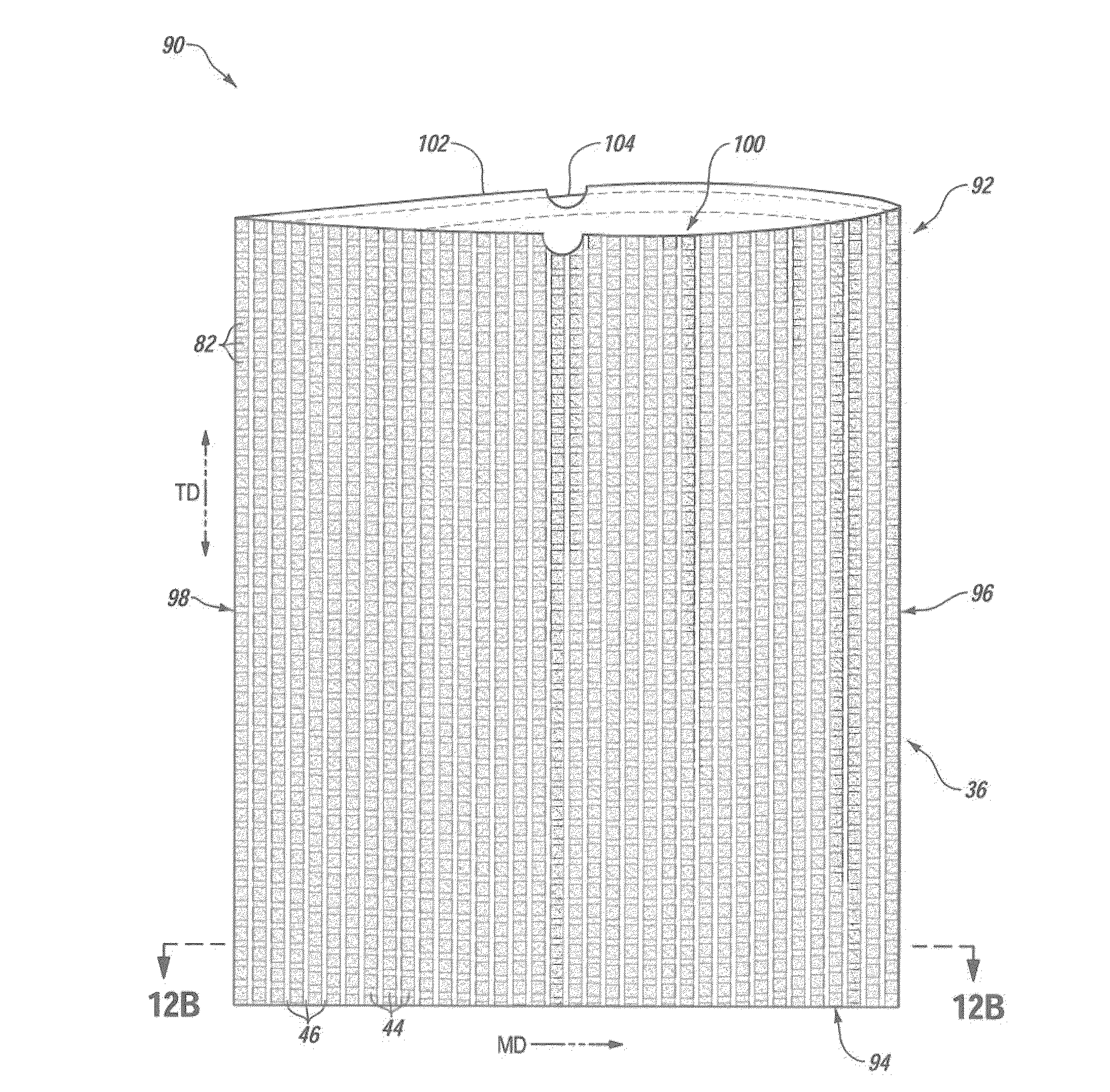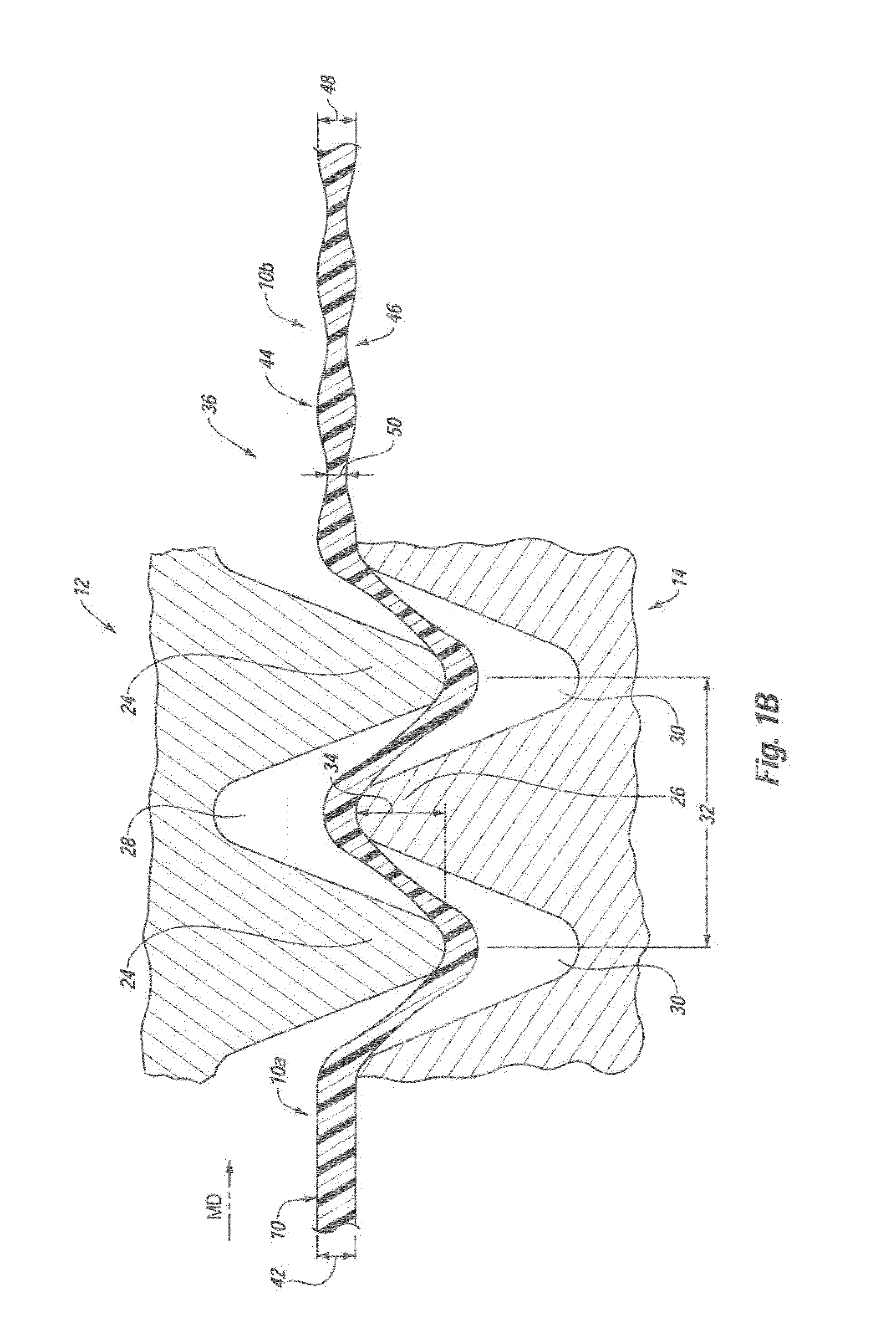Incrementally-Stretched Adhesively-Laminated Films and Methods for Making The Same
a technology of adhesive lamination and thermoplastic film, which is applied in the field of thermoplastic film, can solve the problems of increasing the cost of thermoplastic materials, the film between the rollers is stretched, and the product includes thermoplastic films, so as to reduce the amount of raw materials, maintain or increase the strength parameters, the effect of reducing the gauge or thickness
- Summary
- Abstract
- Description
- Claims
- Application Information
AI Technical Summary
Benefits of technology
Problems solved by technology
Method used
Image
Examples
example 1
[0147]In a first example, a first layer of a base film having a core ply of LLDPE with white pigment and outer plies of LLDPE\LDPE\Antiblock blend was cold MD ring rolled to form an MD ring rolled (RR) film. The MD intermeshing rolls used in Example 1 had a 0.100″ pitch and were set at a DOE of 0.110″. A second layer of the base film was cold TD ring rolled to form a TD RR film. The TD intermeshing rolls used in Example 1 had a 0.060″ pitch and were set at a DOE of 0.032″. The MD RR film and the TD RR film were then laminated together using a butene-1-copolymer, hot melt adhesive, Rextac® RT 2730 at four different coat weights shown in Tables I, II, and III as samples 1-4. Tables I, II, and III also shows comparative properties of the base film, the MD RR film, the TD RR film, the combined MD RR and TD RR films not adhesively laminated together, as well as a thicker film.
TABLE IDynatup and Tear Resistance of Incrementally-Stretched Adhesively-Laminated Films (1 layer MD RR and 1 lay...
example 2
[0151]In Example 2, the same base layer of film as Example 1 was both MD and TD ring rolled using the same ring rolls as Example 1. The two MD and TD RR films were then laminated together using a butene-1-copolymer, hot melt adhesive, Rextac® RT 2730 at five different coat weights shown in Tables IV, V, and VI as samples 5-9.
TABLE IVProperties of Incrementally-Stretched Adhesively-Laminated Films(both layers MD and TD RR)DynatupCoatGageDynatupEnergyWt.byCaliperTensilePeakto maxDartg / sq.Wt.1″ FootPeelLoadload Dropft.(mils)(mils)(g-f)(lb-f)(in. lb-f)F50 (g)Sample 5 0.03000.641.7181.511.511.28254.0Sample 60.01500.651.8525.510.39.61Sample 70.01000.671.8127.610.69.34264.0Sample 80.00750.661.792.279.710.99Sample 9 0.00600.661.877.799.912.21260.0Comparison DataThickerNA0.9 0.88NA4.33.8180Base Film
TABLE VProperties of Incrementally-Stretched Adhesively-Laminated Films (both layers MD and TD RR)MDMDMDMDMDMDTDTensileTensileTensileTensileTensileTearTearYeildPeak 1 StrainPeak 2Strain(g)(g)(lb-f...
example 3
[0154]In Example 3, one white layer of HDPE with a low MD tear resistance was cold stretched by MD ring rolling at 0.110 DOE. Another black layer of LLDPE was cold stretched by MD ring rolling at 0.110 DOE followed by TD ring rolling at 0.032 DOE and then laminated together with the same adhesive. Again, with the two ply laminates superior properties were obtained even at very low adhesive levels compared to a single ply film as shown by the results of Tables VII-IX.
TABLE VIIDynatup and Tear Resistance of Incrementally-Stretched Adhesively-Laminated Films (1 layer MD RR and 1 layer MD and TD RR)DynatupCoatGageDynatup EnergyDartWt.byPeakto maxDropMDg / sq. Wt.Loadload F50TearTD Tearft.(mils) (lb-f)(in. lb-f)(g)(g)(g)Sample 100.0300 0.6711.8311.86284357575Sample 110.0150 0.6711.7914.21357532Sample 120.0100 0.6710.9910.77288373502Sample 130.0075 0.6711.8011.60360530Sample 140.0060 0.6712.6010.57260385535Comparison DataThickerNA0.9 4.33.8180262843Base Film
TABLE VIIIMD Tensile Properties o...
PUM
| Property | Measurement | Unit |
|---|---|---|
| aspect ratio | aaaaa | aaaaa |
| angle | aaaaa | aaaaa |
| angles | aaaaa | aaaaa |
Abstract
Description
Claims
Application Information
 Login to View More
Login to View More - R&D
- Intellectual Property
- Life Sciences
- Materials
- Tech Scout
- Unparalleled Data Quality
- Higher Quality Content
- 60% Fewer Hallucinations
Browse by: Latest US Patents, China's latest patents, Technical Efficacy Thesaurus, Application Domain, Technology Topic, Popular Technical Reports.
© 2025 PatSnap. All rights reserved.Legal|Privacy policy|Modern Slavery Act Transparency Statement|Sitemap|About US| Contact US: help@patsnap.com



